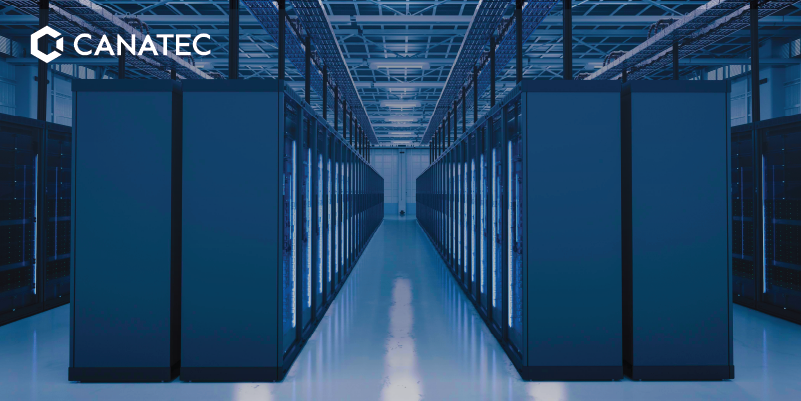
Table of Contents
Part I: Introduction
Data centres have played – and continue to play, a crucial role in our current age of technology. Tasked to collect, store, process, and distribute large amounts of data, they have been around since the advent of the modern computing age.
As technology evolves, so do data centres. With demands for stronger data processing increasing, data centres now consist of millions of servers, routers, switches and networks that are working round the clock to ensure the smooth running of internet services. However, this has raised questions about sustainability as data centres often require a lot of resources to operate. Not only do they need a lot of power to operate, but they also require cooling units to prevent overheating. This, in turn, produces a lot of greenhouse gases which are bad for the environment. Consequently, there needs to be a way for data centres to be more resource-efficient while delivering the same service quality.
Fortunately, that can be done by choosing the right precision cooling system. With a precision cooling system, data centre operators can receive timely information on power consumption and temperatures, make adjustments accordingly and monitor data centre conditions seamlessly. This creates the optimal environment for data centres to lower power usage without compromising on their data processing efficiency.
In this comprehensive guide, everything from the choosing the precision cooling unit to a water leak detection system will be discussed so that data centre operators can make the right decisions in creating the environment for data centres.
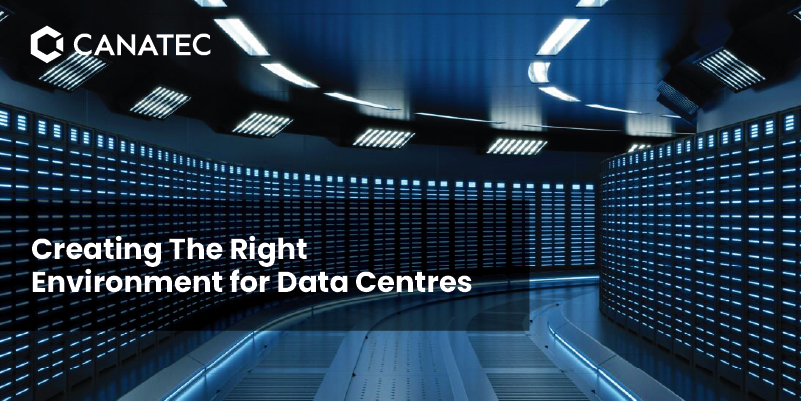
Part II: Creating The Right Environment for Data Centres
2.1. What Does A Good Data Centre Look Like?
In our increasingly digital world, the internet is the one thing that powers almost everything. For the internet to work properly, it needs data – and lots of it. As people are very used to receiving information at the tap of a button, data centres need to be well-maintained so that there is little room for errors to occur. As such, a good data centre will be able to house and process these enormous amounts of data to keep the internet working at all hours of the day.
While data centres may change according to different industries and their requirements, they should have these 5 qualities:
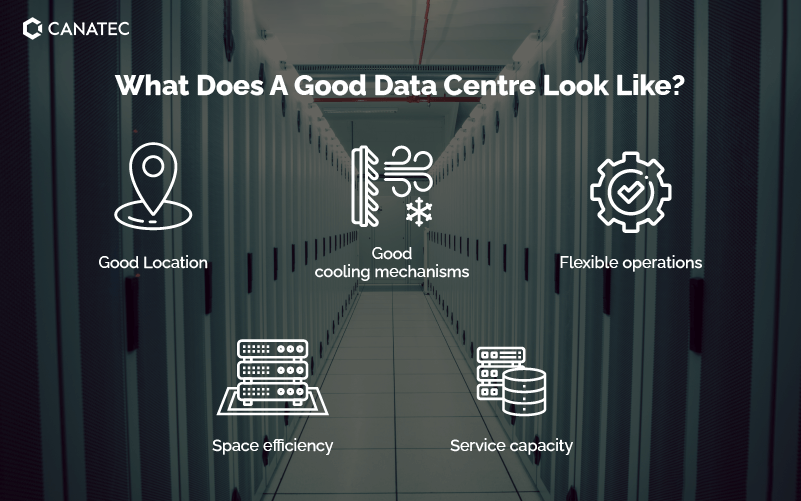
1. Location
Just like a property, a good location can make a difference in the services offered by data centres. If the business has an in-house data centre, they will need to take care of maintenance on their own. If it is an external data centre, it needs to have access to a reliable power supply so that it can function properly. With so much electricity needed, it also generates high volumes of heat, which means that the data centre must have a good cooling system to prevent overheating. This leads to the second point:
2. Good cooling mechanisms
The correct cooling infrastructure can make a big difference in a data centre’s energy efficiency, especially if it allows precise cooling and humidity control. This helps to reduce air re-circulation and prevent server racks being exposed to warm air that may cause it to overheat. Long-term heat exposure can reduce the lifespans of data centres and also result in more breakdowns. As such, a well-maintained data centre should have a precision cooling system that can successfully optimise airflow and allow for greater energy efficiency.
3. Flexibility
Data centres should be able to adapt and evolve to suit the ever-changing needs of technology and businesses. Be it simple upgrades or an almost complete overhaul, data centres should be able to seamlessly integrate these changes into their processes. Moreover, having emergency controls is a must – so that businesses can continue their operations even in the face of major disruptions.
4. Space efficiency
As mentioned earlier, data centres are incredibly resource-intensive, and that includes taking up a lot of space. The largest data centre in the world occupies 6.3 million square feet in China! Nevertheless, this leads to a bigger carbon footprint which hurts the environment. To be more resource-efficient, a good data centre should maximise the space available so that it can leave a smaller footprint. Usually, this means placing more racks per servers and having modular units so that they can be rearranged to optimise space. Even precision cooling units come in modular designs so that they can fit into small spaces.
5. Service capacity
This ties directly with the reliability of the data centre. Does the data centre have strong network speeds? Does it provide collocation so that businesses connect with other networks and data centres if needed? How about the proper security measures and cooling infrastructure? Is the service capacity scalable so that it can support the growing business needs? All of these are important qualities that need to be included when thinking about how a good data centre should look like and function.
2.2. 4 Advantages in Having A Precision Cooling Unit
Data centres are usually highly sensitive to environmental changes and require precise computer room air conditioning to properly maintain its temperature and humidity. With precision cooling units, the optimal environment can be maintained 24/7 and also be energy efficient – resulting in lower power consumption and cost savings. As heat is still generated whether it is a big or small data centre, cooling units are very much needed.
Here are 4 advantages to having precision cooling units:
1. High sensible heat ratio
Sensible heat ratio (SHR) refers to the amount of energy needed to lower the temperature as compared to removing the humidity. IT spaces require an SHR of 0.85 and above for efficient cooling. As precision cooling units have an SHR of 0.95, they are ideal for cooling down data centres. This is in comparison to comfort cooling units such as the standard air conditioning systems, which only have an SHR of 0.65.
2. Precise temperature and humidity
Not only does temperature affect how data centres operate, but so does the relative humidity level. For data centres, 45 to 50% of relative humidity is when they can function the best. Too high humidity means too much moisture – leading to corrosion and condensation ruining surfaces. While too low humidity results in higher chances of static discharge, which can damage equipment. As data centres can be sensitive to fluctuations, precision cooling units ensure that the perfect temperature and humidity levels are maintained 24/7, 365 days per year. No matter the type of environment, they are equipped with network controls that allow operators to monitor the environment closely and adjust it accordingly.
3. Better air quality
A key feature of precision cooling units is their ability to improve air distribution and prevent the formation of localised ‘hot spots’. This is because they are equipped with highly efficient filter banks that can filter out air and prevent the accumulation of dust particles. This is especially suited for cold/hot aisle containment environments where directed cooling is required.
4. 24/7 operational hours
As data centres are working 24/7, so should cooling systems. As such, precision cooling units are designed to operate for as long as data centres operate. While the fans operate all year round, the addition of variable controls ensures that temperature and humidity sensors can be adjusted accordingly. This ensures energy efficiency even in highly sensitive environments. While operational hours of precision computer room air conditioning can be affected by room conditions and heat load, technological advancements have resulted in models that can easily adapt to changing heat loads – like the Canatec R Series.
2.3. CRAC versus CRAH – What is the difference?
The main advantage of having a precision cooling system lies in its ability to optimise air circulation for greater data centre cooling. This resulted from the hot and cold aisle arrangement where servers are arranged in such a way that hot and cold aisles are alternating throughout the room.
For precision air conditioning in server rooms to work effectively, the fronts of servers are facing each other in the cold aisle so that cold air, from the precision air conditioning unit, can be pumped through the perforated tiles on elevated floors and cool down the servers. Meanwhile, the backs of servers are facing each other in the hot aisle and whenever hot air is produced, it will be pulled in by the air conditioner. This air distribution method is often referred to as the under-floor system, as cold air travels along the floor to cool down the servers while the hot air is released from the top.
Many data centres use different types of cooling systems as it is a good way to optimise airflows and allow for better cooling. One is a Computer Room Air Conditioner (CRAC) and the other is a Computer Room Air Handler (CRAH). While both functions to cool down data centres, they consist of different mechanisms to do so.
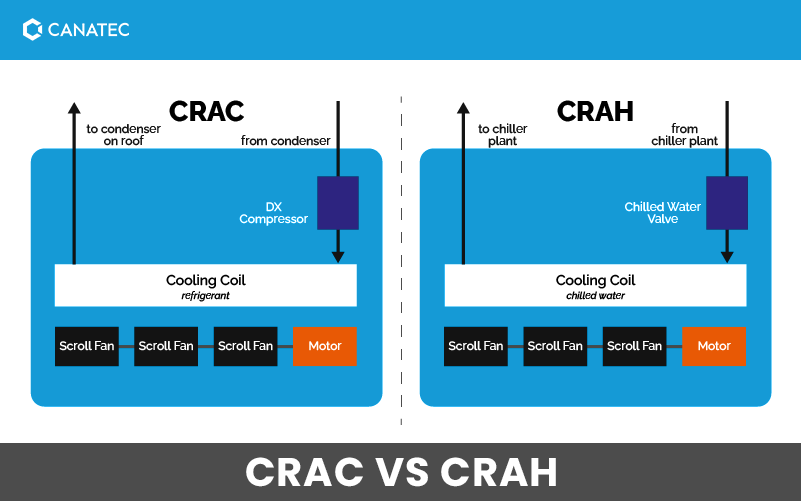
A CRAC is fitted with refrigerant-filled coils wherein hot air is cooled when passed over them. A compressor is built inside a CRAC to keep the coils cold and so, they do not require a chilled water system to work. However, the hot air produced by the compressors needs to be expelled properly so that it does not cause overheating. As such, CRAC units are often thought to be more high maintenance.
On the other hand, CRAH does not have an internal refrigerant and instead rely on fans and a chilled-water system for heat removal – making them more energy efficient.
Nevertheless, each type of precision air conditioning has its advantages and it largely depends on data centres’ unique environmental needs to understand which type of cooling unit will work best.
2.4. Top 3 Reasons for Investing In A Water Leak Detection System
Data centres should not only be protected from overheating, but also from excess moisture. Given the fact that these centres are filled with air conditioning units, chilled water systems and pipes, the risks of significant disruption caused by water leakages are quite high. Moreover, water damage in data centres can result in large economic losses due to the resultant data loss forcing as much as 43% of companies to close down. Consequently, water detection has to happen early so that maintenance can be done quickly and before causing much damage to the equipment. As such, investing in a water leak detection system is crucial.
Here are 3 reasons why all data centres have to be equipped with water leak detection systems.
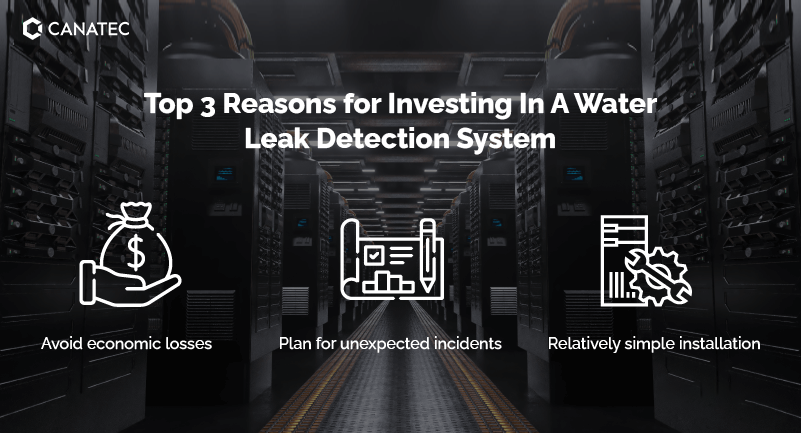
1. Avoid loss
As mentioned above, water damage has the potential to cause economic losses. Especially in data centres with elevated floors, water leaks can be difficult to detect by sight alone as they can be hidden. It is often the case that once water leaks have been sighted, it means that extensive damage to the equipment has already occurred. As such, it is important to catch water leaks at its source so that it can be dealt with swiftly. That’s why water leak detection systems are equipped with sensing cables that can immediately detect water leaks.
2. Plan for unexpected incidents
Many water leak detection systems, such as Tracetek water detection system, are often hooked up to other host systems so that they can communicate water leak information accurately. Having host systems that collect and store such data allows operators to analyse water flow information and pinpoint problem areas such as frequently leaking pipes or an AC unit that might not be functioning properly. In such situations, data centre operators can immediately make adjustments once they are made aware of the issue and prevent future catastrophes. Maintenance can be done promptly and even cost savings can be ensured.
3. Relatively simple installation
Often consisting of modular designs, a single water leak detection module can monitor up to 1500 metres of sensing cable. While some models require being directly connected to sensing cables, others can work remotely – which is perfect for large data centres. This allows for space efficiency as water leak detection modules are small and compact. With no field calibration required, water leak detection systems can be installed fast and start working almost immediately. Tracetek even has a Touch Screen Panel (TT-TS12) where information about the sensing cable networks and leak locations can be displayed on a graphic interface. While many water leak detection systems are equipped with alarms to notify instances of a water leak, in large data centres, that might not be enough. Having a touch panel can easily show the exact location of the leak so that maintenance can happen quickly.
The adage, ‘prevention is better than cure,’ applies heavily in the case of installing a water leak detection system. Especially since data centre equipment is getting more complex, water damage can be irreversible and impossible to fix. As such, it will be in the best interest of data centre operators to invest in water leak detection systems to properly safeguard their equipment.

Part III: How To Maintain Data Centres Properly
3.1. 5 Tips for Ensuring an Efficient And Sustainable Data Centre
Data centres still require human operators to ensure that everything is running smoothly. Especially for precision cooling units and water leak detection systems, constant monitoring and maintenance are needed to ensure that these types of equipment are in working order.
Consequently, there are a few things that need to be to keep data centres in operational condition and minimise disruptions.
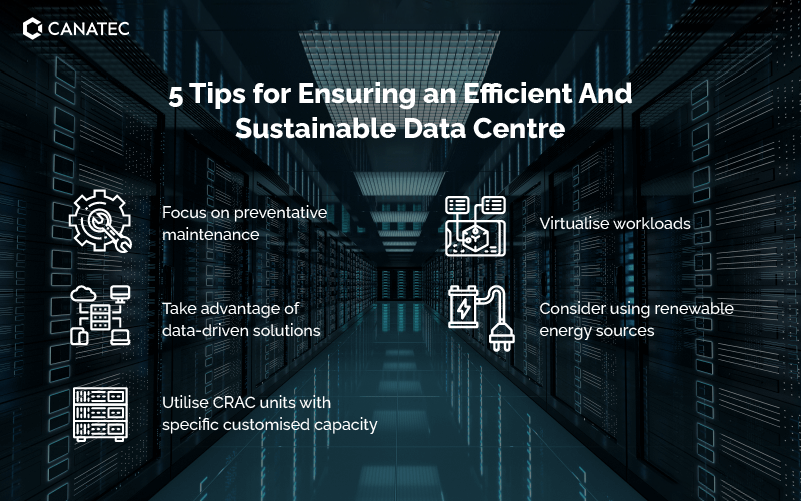
1. Focus on preventive maintenance
All data centres should have robust business continuity plans to ensure that in cases of unforeseen circumstances, emergency protocols can be deployed at once. This means continuously backing up data which ensures that if the master IT equipment is damaged, the data centre can still deliver on its services with minimal disruption. Moreover, data centre equipment should be checked regularly to ensure that they are in good working order. Especially CRAC units as they are also at risk of overheating. Besides, water leak detection systems are useful in alerting operators to equipment irregularities at the early stages so that the issue can be dealt with quickly.
2. Take advantage of data-driven solutions
Even data centre operators should take advantage of data analytics to come up with strategies that will increase the efficiency of operations. By collecting and analysing real-time information about the inner workings of the data centre, operators can easily gauge if they need more cooling, reduce power consumption or better manage aisle temperatures. Moreover, this helps data centres to reduce overcooling by precision air conditioning units as they can effectively monitor how much server racks need to be cooled. With technology moving at a fast pace, data-driven solutions will ensure that data centres are always working in excellent conditions to keep up with technological advancements.
3. Utilise CRAC units with specific customised capacity
While it is a known fact that data centres expend a lot of power, many may not know that air cooling units consume the largest amount of power right after the main hardware. Therefore, a way to optimise space and energy in data centres is to use precision air conditioning units that operate at a high level of cooling efficiency while maintaining a smaller carbon footprint. This can be achieved by implementing CRAC units that allow operators to customise the kilowatt (kW) capacity to suit unique projects, such as Canatec’s series of CRAC units. While they are standard models, their kW capacities can be customised to fit different requirements of data centres and still offer a reliable level of temperature and humidity control. Subsequently, data centres can utilise fewer CRAC units which ensure energy and space efficiency, and ultimately, cost savings. Moreover, with a smaller footprint, CRAC units will be more sustainable and can last for a longer time.
4. Enhanced heat containment measures
As high-density racks are a staple in large data centres, the heat exhaust they produce has to be properly disposed of to reduce ‘hot spots’. In a hot aisle/cold aisle layout, this means ensuring that the heat does not get into the cold aisle and raise the temperature. As such, operators should properly enclose the hot aisle so that the precision air conditioning units can vent out the hot air and keep it separate for the cold air streams. Consequently, this does away with the need for a raised floor for cold air, thus reducing energy usage.
5. Consider using renewable energy sources
Depending on how your data centre operates, this may be difficult or easy to do so. Nonetheless, renewable energy sources are one of the best ways to ensure the sustainability of data centres. Operators can consider slowly transitioning to renewable resources such as solar and wind energy. That’s why the location of data centres are so important, as being located near renewable sources of energy can result in more efficient power usage, especially since CRAC units can expend a lot of energy.
While these tips might seem like a lot, taking small steps can help data centres to become more efficient and sustainable.
3.2. Don’t Forget About Security
Data centres being the literal heart of the internet, they need to be protected as such. No matter the size of the data centre, it still carries valuable and sensitive information. Subsequently, ensuring the physical and cybersecurity of the data centre is of paramount importance.
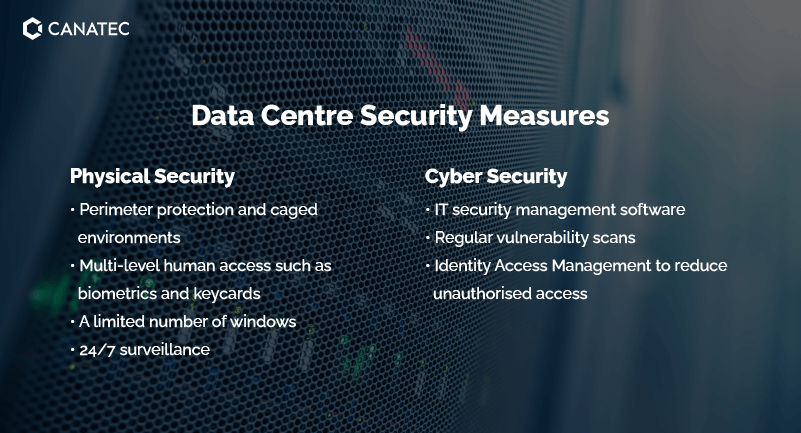
For physical security, data centres should be fitted with multi-level security features such as perimeter protection, caged environments and secure racks. Moreover, there should be different layers of access such as biometrics and keycards to minimise the risks of unauthorised entries. Many data centres also have a limited number of windows to reduce chances of break-ins and 24/7 surveillance so that security guards can monitor conditions effectively. Precision air conditioning units should also be subjected to similar physical security measures as the main hardware may not be able to function without them.
Cybersecurity has been a growing concern in recent years as malware and spyware attacks become more common. As a result, data centre operators will also need to invest in IT security management software so that sensitive data can be safeguarded against cyber threats. Vulnerability scans should be conducted regularly so that weak points can be exposed and patched. Identity access management (IAM) should also be considered so that only authorised personnel can gain access to important information.
With the proper security measures in place, data centres can continue to operate at optimal levels with fewer chances of interruptions happening.
Part IV: Conclusion
Data centres are technology rooms that often house delicate and expensive equipment that require a near-exact environment to run smoothly. Precision cooling systems and water leak detection systems can provide such a stable environment so that businesses can avoid system downtime. Furthermore, as the world’s data is predicted to grow from 33 zettabytes to 175 zettabytes by 2025, the energy consumption of data centres is expected to grow as well. This means a larger carbon footprint and therefore, data centres must find more sustainable and efficient ways to operate data centres. Be it through data-driven solutions or renewable energy sources, eco-friendly data centres are the future.
Canatec aims to provide data centres with CRAC units and water leak detection systems that are made from cutting-edge technology for greater energy efficiency and reliability! Contact us today for more information.
